Feminist Research on Violence Against Women in Australia
VerifiedAdded on 2022/12/07
|10
|2672
|210
Essay
AI Summary
This essay, written for a CCJ 2007 course, examines the social problem of violence against women in Australia, focusing on the contributions of feminist research and theories. The essay begins by defining violence against women and its various forms, including intimate partner violence, and then explores the impact of feminist perspectives on understanding the causes and potential solutions to this issue. The essay highlights the differences between feminist theories and other theories of violent offending, emphasizing the role of gender and patriarchal structures. Focusing on domestic violence as a specific example, the essay constructs a feminist analysis, drawing on social learning and conflict theories to explain the causes, social contexts, and other relevant factors. The influence of feminist theories on the Australian legal system is also discussed, emphasizing the ongoing need for greater justice. The essay concludes by summarizing the main points and highlighting the significant consequences of violence against women, including physical injuries, mental health issues, and financial burdens. The essay references relevant literature to support the arguments and analysis, contributing to a comprehensive understanding of the issue.
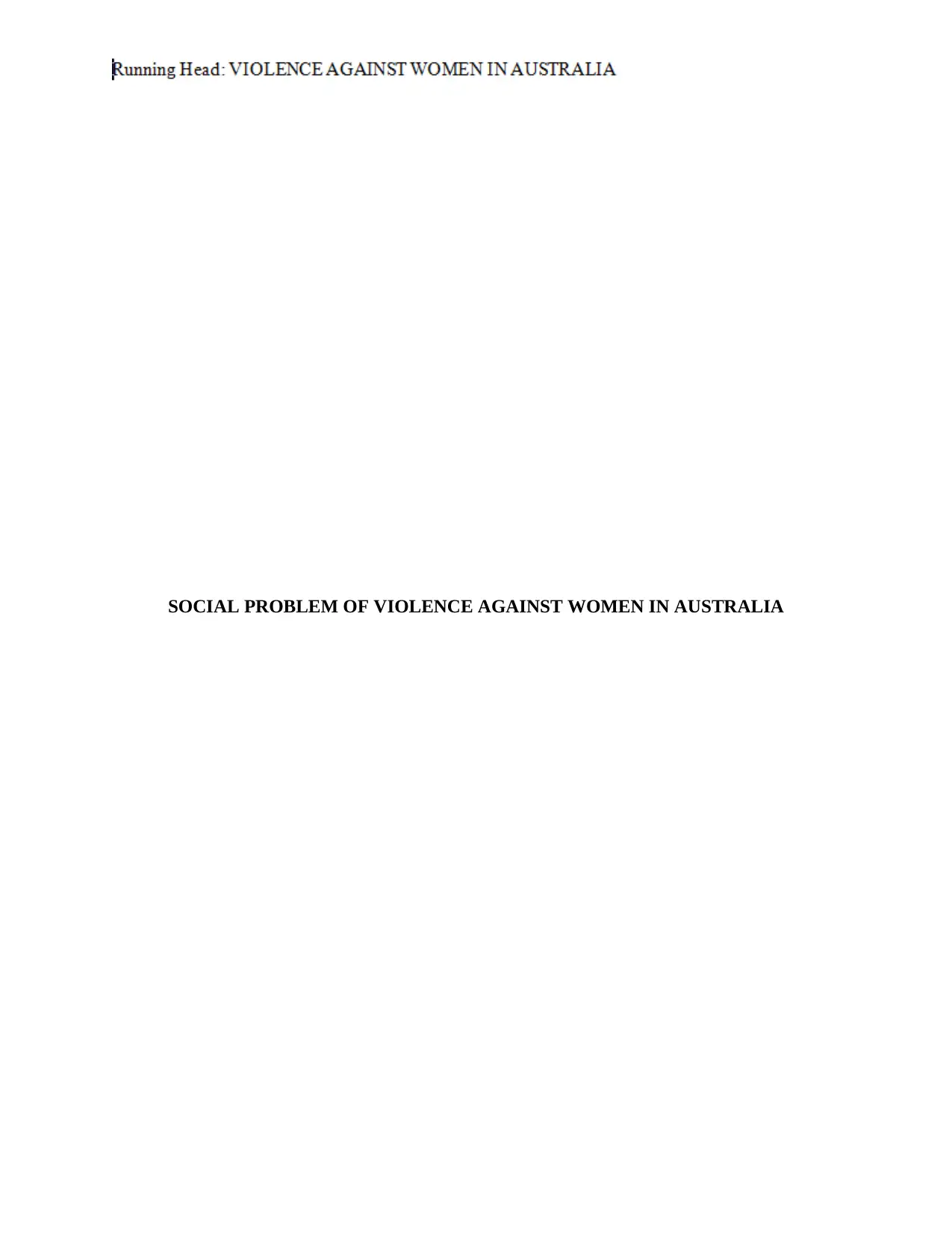
SOCIAL PROBLEM OF VIOLENCE AGAINST WOMEN IN AUSTRALIA
Paraphrase This Document
Need a fresh take? Get an instant paraphrase of this document with our AI Paraphraser

Introduction
Violence against women includes gender-based violence and sexual and gender-based
violence, committed against girls and women (DeKeseredy & Schwartz, 2011). It is a hate crime
and committed expressively because they are females. Feminist activists and scholars brought
domestic violence, sexual assault and stalking into public consciousness since the year 1970s.
These various offenses are broadly categorized as ‘violence against women’ and are now viewed
by policymakers and criminologists as a social problem in Australia an the entire world.
Violence against women has many forms of honor killing, trafficking, sexual violence such as
conflict-related sexual violence, intimate partner violence such as sexual, physical and emotional
abuse, forced early marriage, and female genital mutilation, as identified by the World Health
Organization (Hunnicutt, 2009). One of the most common violence against women is intimate
partner violence. Violence against women is widespread and occurs in most countries around the
world, but it varies from country to country. In the current scope of discussion contribution from
feminists theories on violence against women is undertaken with analysis of domestic violence
as important violence against women.
Contribution of Feminists Research and theories on violence against women
In order to understand a social problem and take measures to prevent it, one needs to
have a proper understanding of the root causes behind the same. The researches carried out
studies regarding the factors responsible for violence against women follows two lines of
thoughts. Firstly, the characteristics that impacted the behaviors of offenders are examined and
secondly, whether some women experience an intense vulnerability towards being victimized is
also considered (Alhabib, Nur & Jones, 2010).
2
Violence against women includes gender-based violence and sexual and gender-based
violence, committed against girls and women (DeKeseredy & Schwartz, 2011). It is a hate crime
and committed expressively because they are females. Feminist activists and scholars brought
domestic violence, sexual assault and stalking into public consciousness since the year 1970s.
These various offenses are broadly categorized as ‘violence against women’ and are now viewed
by policymakers and criminologists as a social problem in Australia an the entire world.
Violence against women has many forms of honor killing, trafficking, sexual violence such as
conflict-related sexual violence, intimate partner violence such as sexual, physical and emotional
abuse, forced early marriage, and female genital mutilation, as identified by the World Health
Organization (Hunnicutt, 2009). One of the most common violence against women is intimate
partner violence. Violence against women is widespread and occurs in most countries around the
world, but it varies from country to country. In the current scope of discussion contribution from
feminists theories on violence against women is undertaken with analysis of domestic violence
as important violence against women.
Contribution of Feminists Research and theories on violence against women
In order to understand a social problem and take measures to prevent it, one needs to
have a proper understanding of the root causes behind the same. The researches carried out
studies regarding the factors responsible for violence against women follows two lines of
thoughts. Firstly, the characteristics that impacted the behaviors of offenders are examined and
secondly, whether some women experience an intense vulnerability towards being victimized is
also considered (Alhabib, Nur & Jones, 2010).
2
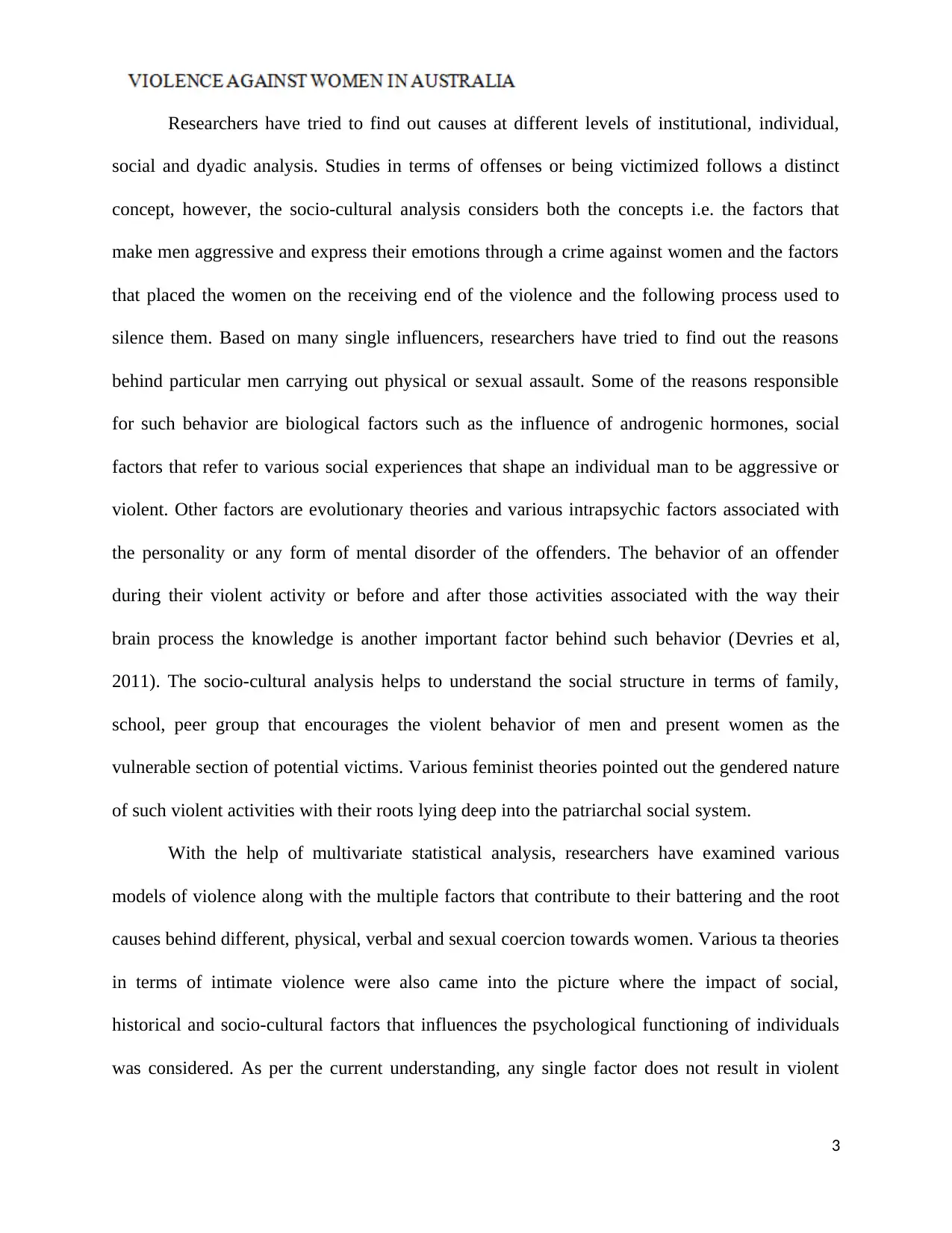
Researchers have tried to find out causes at different levels of institutional, individual,
social and dyadic analysis. Studies in terms of offenses or being victimized follows a distinct
concept, however, the socio-cultural analysis considers both the concepts i.e. the factors that
make men aggressive and express their emotions through a crime against women and the factors
that placed the women on the receiving end of the violence and the following process used to
silence them. Based on many single influencers, researchers have tried to find out the reasons
behind particular men carrying out physical or sexual assault. Some of the reasons responsible
for such behavior are biological factors such as the influence of androgenic hormones, social
factors that refer to various social experiences that shape an individual man to be aggressive or
violent. Other factors are evolutionary theories and various intrapsychic factors associated with
the personality or any form of mental disorder of the offenders. The behavior of an offender
during their violent activity or before and after those activities associated with the way their
brain process the knowledge is another important factor behind such behavior (Devries et al,
2011). The socio-cultural analysis helps to understand the social structure in terms of family,
school, peer group that encourages the violent behavior of men and present women as the
vulnerable section of potential victims. Various feminist theories pointed out the gendered nature
of such violent activities with their roots lying deep into the patriarchal social system.
With the help of multivariate statistical analysis, researchers have examined various
models of violence along with the multiple factors that contribute to their battering and the root
causes behind different, physical, verbal and sexual coercion towards women. Various ta theories
in terms of intimate violence were also came into the picture where the impact of social,
historical and socio-cultural factors that influences the psychological functioning of individuals
was considered. As per the current understanding, any single factor does not result in violent
3
social and dyadic analysis. Studies in terms of offenses or being victimized follows a distinct
concept, however, the socio-cultural analysis considers both the concepts i.e. the factors that
make men aggressive and express their emotions through a crime against women and the factors
that placed the women on the receiving end of the violence and the following process used to
silence them. Based on many single influencers, researchers have tried to find out the reasons
behind particular men carrying out physical or sexual assault. Some of the reasons responsible
for such behavior are biological factors such as the influence of androgenic hormones, social
factors that refer to various social experiences that shape an individual man to be aggressive or
violent. Other factors are evolutionary theories and various intrapsychic factors associated with
the personality or any form of mental disorder of the offenders. The behavior of an offender
during their violent activity or before and after those activities associated with the way their
brain process the knowledge is another important factor behind such behavior (Devries et al,
2011). The socio-cultural analysis helps to understand the social structure in terms of family,
school, peer group that encourages the violent behavior of men and present women as the
vulnerable section of potential victims. Various feminist theories pointed out the gendered nature
of such violent activities with their roots lying deep into the patriarchal social system.
With the help of multivariate statistical analysis, researchers have examined various
models of violence along with the multiple factors that contribute to their battering and the root
causes behind different, physical, verbal and sexual coercion towards women. Various ta theories
in terms of intimate violence were also came into the picture where the impact of social,
historical and socio-cultural factors that influences the psychological functioning of individuals
was considered. As per the current understanding, any single factor does not result in violent
3
⊘ This is a preview!⊘
Do you want full access?
Subscribe today to unlock all pages.

Trusted by 1+ million students worldwide

behavior. As a result, several factors that stemmed out from each-single factor domain are
explained to understand how each factor contributes to such violent activity. This discussion
would be followed by a review to establish a multifactor model.
Difference between Feminist theories & other theories of violent offending
According to feminist theory, firstly, the gender - a term created by the society in
reference to the behavior and attitude of men and women, is a central component of social life
that includes the criminal offenses, the process of victimization and also the processing of
criminal justice (Devries et al, 2013). On the contrary theories of violent offending states from an
evolutionary perspective that the goal of sexual behavior is to maximize the the chances of
passing one's genes. Individual determinants goal includes impregnating females by best-serving
males. The difference in sex determines mating strategies for reproductive success.
Secondly, owing to the patriarchal system that values men over women, the women were
either excluded or treated as insignificant in criminology, both as a subject of study as well as
professionals. As a result, the most important principle of this theory is to involve the
perspectives and experiences of women in every research and practices. The feminist's theory
also recognizes that gender privilege varies between different sections of men and women. The
violent theory of offending states that males having difficulty in obtaining a partner is more
likely to resort to rape or sexual coercion. There is extreme evidence of forced mating amongst
animals. Evolutionary theory also explains this aspect of intimate partner violence.
The third principle of this theory is to carry out an examination of criminal offenses,
victimization and the processing of criminal justice in relation to various social factors such as
gender, ethnicity, social class, race, age, and sexual orientation. Theory of violent offending
4
explained to understand how each factor contributes to such violent activity. This discussion
would be followed by a review to establish a multifactor model.
Difference between Feminist theories & other theories of violent offending
According to feminist theory, firstly, the gender - a term created by the society in
reference to the behavior and attitude of men and women, is a central component of social life
that includes the criminal offenses, the process of victimization and also the processing of
criminal justice (Devries et al, 2013). On the contrary theories of violent offending states from an
evolutionary perspective that the goal of sexual behavior is to maximize the the chances of
passing one's genes. Individual determinants goal includes impregnating females by best-serving
males. The difference in sex determines mating strategies for reproductive success.
Secondly, owing to the patriarchal system that values men over women, the women were
either excluded or treated as insignificant in criminology, both as a subject of study as well as
professionals. As a result, the most important principle of this theory is to involve the
perspectives and experiences of women in every research and practices. The feminist's theory
also recognizes that gender privilege varies between different sections of men and women. The
violent theory of offending states that males having difficulty in obtaining a partner is more
likely to resort to rape or sexual coercion. There is extreme evidence of forced mating amongst
animals. Evolutionary theory also explains this aspect of intimate partner violence.
The third principle of this theory is to carry out an examination of criminal offenses,
victimization and the processing of criminal justice in relation to various social factors such as
gender, ethnicity, social class, race, age, and sexual orientation. Theory of violent offending
4
Paraphrase This Document
Need a fresh take? Get an instant paraphrase of this document with our AI Paraphraser
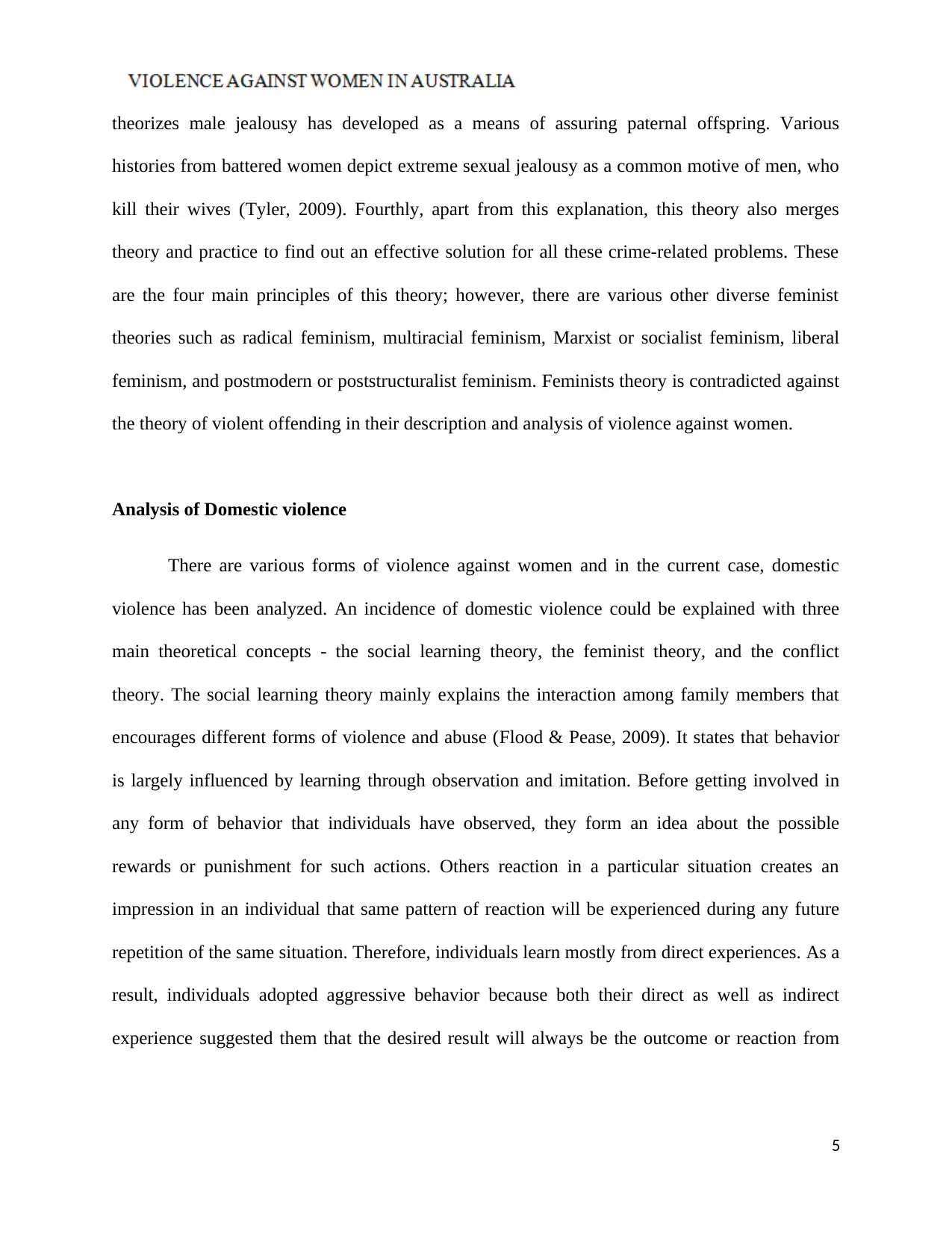
theorizes male jealousy has developed as a means of assuring paternal offspring. Various
histories from battered women depict extreme sexual jealousy as a common motive of men, who
kill their wives (Tyler, 2009). Fourthly, apart from this explanation, this theory also merges
theory and practice to find out an effective solution for all these crime-related problems. These
are the four main principles of this theory; however, there are various other diverse feminist
theories such as radical feminism, multiracial feminism, Marxist or socialist feminism, liberal
feminism, and postmodern or poststructuralist feminism. Feminists theory is contradicted against
the theory of violent offending in their description and analysis of violence against women.
Analysis of Domestic violence
There are various forms of violence against women and in the current case, domestic
violence has been analyzed. An incidence of domestic violence could be explained with three
main theoretical concepts - the social learning theory, the feminist theory, and the conflict
theory. The social learning theory mainly explains the interaction among family members that
encourages different forms of violence and abuse (Flood & Pease, 2009). It states that behavior
is largely influenced by learning through observation and imitation. Before getting involved in
any form of behavior that individuals have observed, they form an idea about the possible
rewards or punishment for such actions. Others reaction in a particular situation creates an
impression in an individual that same pattern of reaction will be experienced during any future
repetition of the same situation. Therefore, individuals learn mostly from direct experiences. As a
result, individuals adopted aggressive behavior because both their direct as well as indirect
experience suggested them that the desired result will always be the outcome or reaction from
5
histories from battered women depict extreme sexual jealousy as a common motive of men, who
kill their wives (Tyler, 2009). Fourthly, apart from this explanation, this theory also merges
theory and practice to find out an effective solution for all these crime-related problems. These
are the four main principles of this theory; however, there are various other diverse feminist
theories such as radical feminism, multiracial feminism, Marxist or socialist feminism, liberal
feminism, and postmodern or poststructuralist feminism. Feminists theory is contradicted against
the theory of violent offending in their description and analysis of violence against women.
Analysis of Domestic violence
There are various forms of violence against women and in the current case, domestic
violence has been analyzed. An incidence of domestic violence could be explained with three
main theoretical concepts - the social learning theory, the feminist theory, and the conflict
theory. The social learning theory mainly explains the interaction among family members that
encourages different forms of violence and abuse (Flood & Pease, 2009). It states that behavior
is largely influenced by learning through observation and imitation. Before getting involved in
any form of behavior that individuals have observed, they form an idea about the possible
rewards or punishment for such actions. Others reaction in a particular situation creates an
impression in an individual that same pattern of reaction will be experienced during any future
repetition of the same situation. Therefore, individuals learn mostly from direct experiences. As a
result, individuals adopted aggressive behavior because both their direct as well as indirect
experience suggested them that the desired result will always be the outcome or reaction from
5
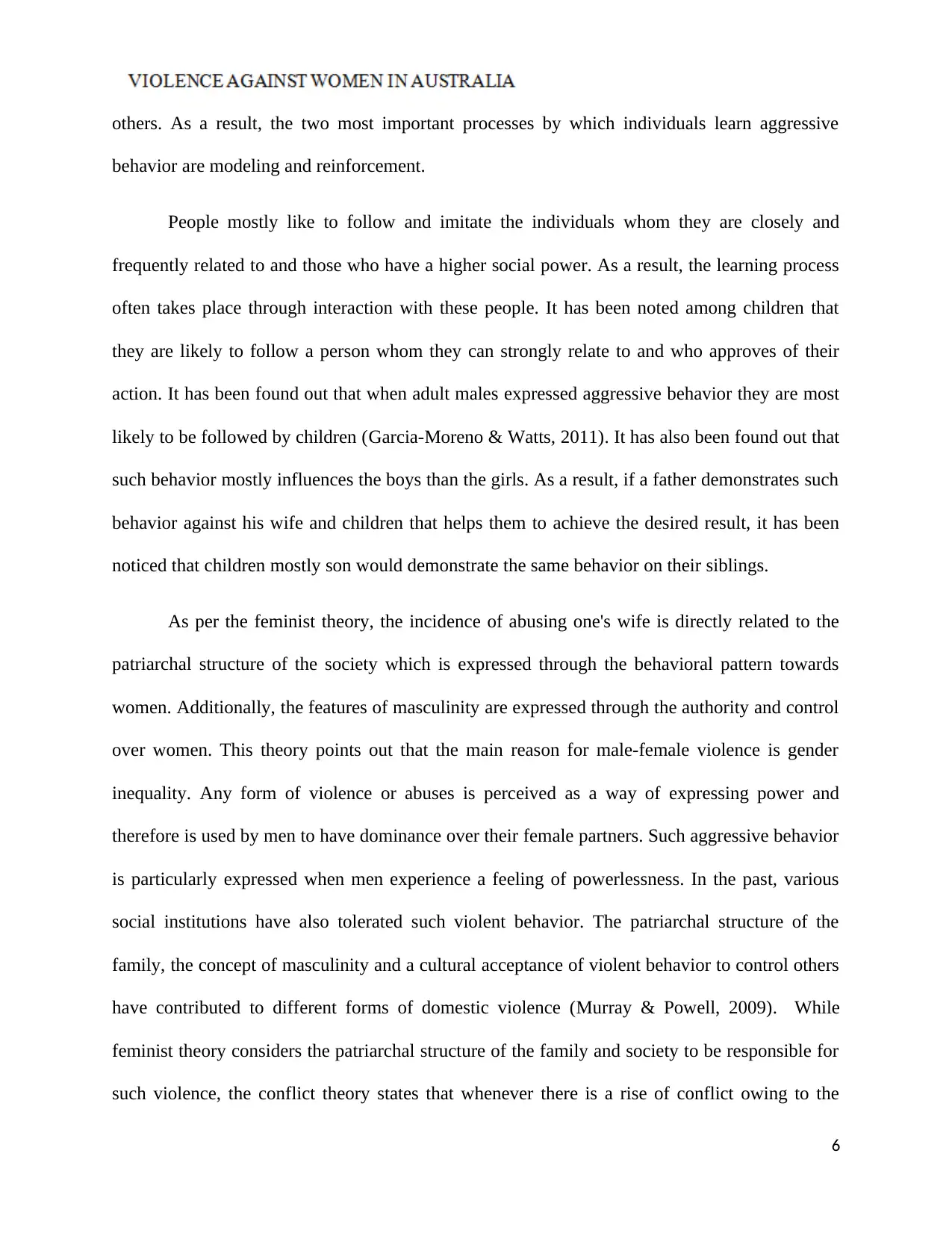
others. As a result, the two most important processes by which individuals learn aggressive
behavior are modeling and reinforcement.
People mostly like to follow and imitate the individuals whom they are closely and
frequently related to and those who have a higher social power. As a result, the learning process
often takes place through interaction with these people. It has been noted among children that
they are likely to follow a person whom they can strongly relate to and who approves of their
action. It has been found out that when adult males expressed aggressive behavior they are most
likely to be followed by children (Garcia-Moreno & Watts, 2011). It has also been found out that
such behavior mostly influences the boys than the girls. As a result, if a father demonstrates such
behavior against his wife and children that helps them to achieve the desired result, it has been
noticed that children mostly son would demonstrate the same behavior on their siblings.
As per the feminist theory, the incidence of abusing one's wife is directly related to the
patriarchal structure of the society which is expressed through the behavioral pattern towards
women. Additionally, the features of masculinity are expressed through the authority and control
over women. This theory points out that the main reason for male-female violence is gender
inequality. Any form of violence or abuses is perceived as a way of expressing power and
therefore is used by men to have dominance over their female partners. Such aggressive behavior
is particularly expressed when men experience a feeling of powerlessness. In the past, various
social institutions have also tolerated such violent behavior. The patriarchal structure of the
family, the concept of masculinity and a cultural acceptance of violent behavior to control others
have contributed to different forms of domestic violence (Murray & Powell, 2009). While
feminist theory considers the patriarchal structure of the family and society to be responsible for
such violence, the conflict theory states that whenever there is a rise of conflict owing to the
6
behavior are modeling and reinforcement.
People mostly like to follow and imitate the individuals whom they are closely and
frequently related to and those who have a higher social power. As a result, the learning process
often takes place through interaction with these people. It has been noted among children that
they are likely to follow a person whom they can strongly relate to and who approves of their
action. It has been found out that when adult males expressed aggressive behavior they are most
likely to be followed by children (Garcia-Moreno & Watts, 2011). It has also been found out that
such behavior mostly influences the boys than the girls. As a result, if a father demonstrates such
behavior against his wife and children that helps them to achieve the desired result, it has been
noticed that children mostly son would demonstrate the same behavior on their siblings.
As per the feminist theory, the incidence of abusing one's wife is directly related to the
patriarchal structure of the society which is expressed through the behavioral pattern towards
women. Additionally, the features of masculinity are expressed through the authority and control
over women. This theory points out that the main reason for male-female violence is gender
inequality. Any form of violence or abuses is perceived as a way of expressing power and
therefore is used by men to have dominance over their female partners. Such aggressive behavior
is particularly expressed when men experience a feeling of powerlessness. In the past, various
social institutions have also tolerated such violent behavior. The patriarchal structure of the
family, the concept of masculinity and a cultural acceptance of violent behavior to control others
have contributed to different forms of domestic violence (Murray & Powell, 2009). While
feminist theory considers the patriarchal structure of the family and society to be responsible for
such violence, the conflict theory states that whenever there is a rise of conflict owing to the
6
⊘ This is a preview!⊘
Do you want full access?
Subscribe today to unlock all pages.

Trusted by 1+ million students worldwide
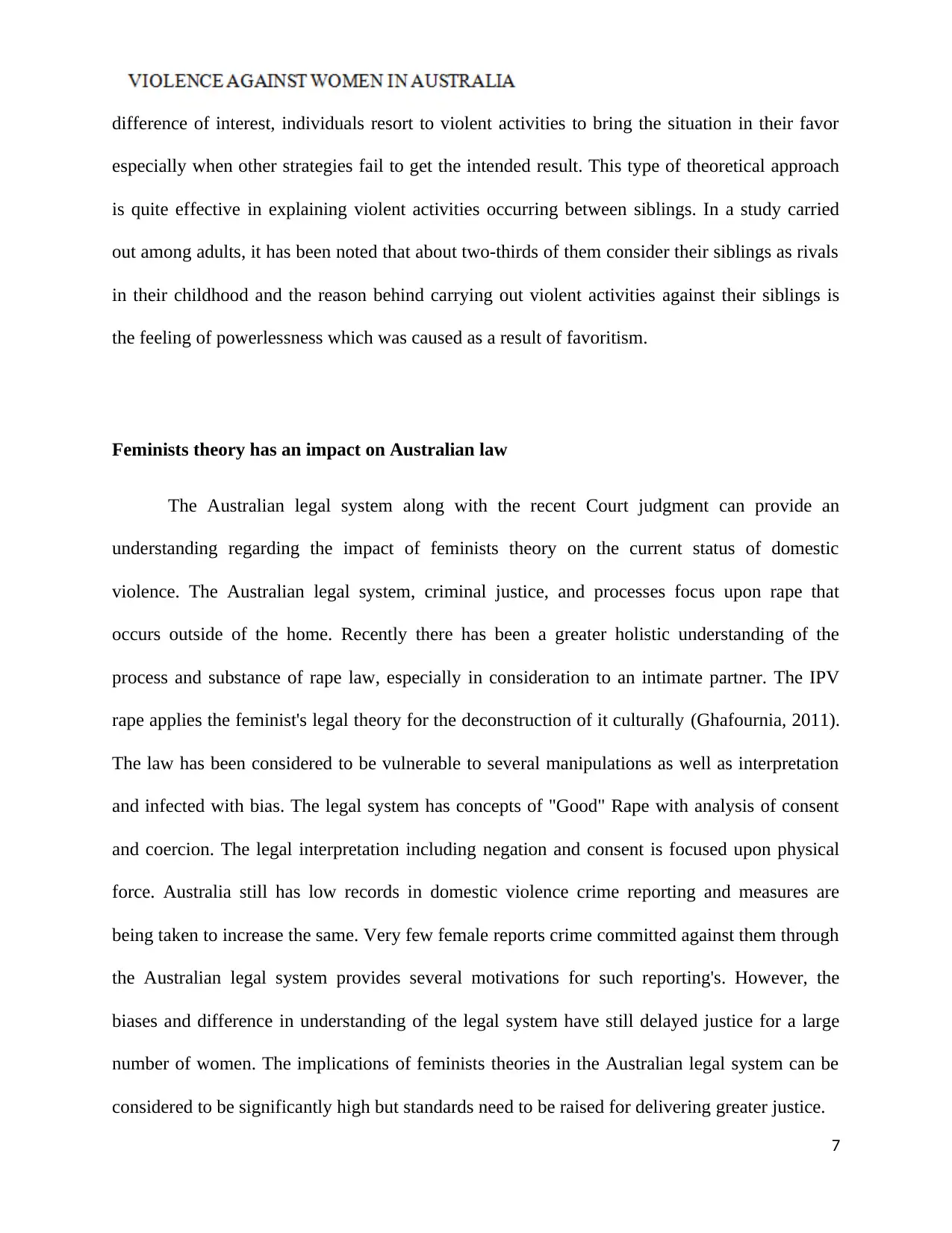
difference of interest, individuals resort to violent activities to bring the situation in their favor
especially when other strategies fail to get the intended result. This type of theoretical approach
is quite effective in explaining violent activities occurring between siblings. In a study carried
out among adults, it has been noted that about two-thirds of them consider their siblings as rivals
in their childhood and the reason behind carrying out violent activities against their siblings is
the feeling of powerlessness which was caused as a result of favoritism.
Feminists theory has an impact on Australian law
The Australian legal system along with the recent Court judgment can provide an
understanding regarding the impact of feminists theory on the current status of domestic
violence. The Australian legal system, criminal justice, and processes focus upon rape that
occurs outside of the home. Recently there has been a greater holistic understanding of the
process and substance of rape law, especially in consideration to an intimate partner. The IPV
rape applies the feminist's legal theory for the deconstruction of it culturally (Ghafournia, 2011).
The law has been considered to be vulnerable to several manipulations as well as interpretation
and infected with bias. The legal system has concepts of "Good" Rape with analysis of consent
and coercion. The legal interpretation including negation and consent is focused upon physical
force. Australia still has low records in domestic violence crime reporting and measures are
being taken to increase the same. Very few female reports crime committed against them through
the Australian legal system provides several motivations for such reporting's. However, the
biases and difference in understanding of the legal system have still delayed justice for a large
number of women. The implications of feminists theories in the Australian legal system can be
considered to be significantly high but standards need to be raised for delivering greater justice.
7
especially when other strategies fail to get the intended result. This type of theoretical approach
is quite effective in explaining violent activities occurring between siblings. In a study carried
out among adults, it has been noted that about two-thirds of them consider their siblings as rivals
in their childhood and the reason behind carrying out violent activities against their siblings is
the feeling of powerlessness which was caused as a result of favoritism.
Feminists theory has an impact on Australian law
The Australian legal system along with the recent Court judgment can provide an
understanding regarding the impact of feminists theory on the current status of domestic
violence. The Australian legal system, criminal justice, and processes focus upon rape that
occurs outside of the home. Recently there has been a greater holistic understanding of the
process and substance of rape law, especially in consideration to an intimate partner. The IPV
rape applies the feminist's legal theory for the deconstruction of it culturally (Ghafournia, 2011).
The law has been considered to be vulnerable to several manipulations as well as interpretation
and infected with bias. The legal system has concepts of "Good" Rape with analysis of consent
and coercion. The legal interpretation including negation and consent is focused upon physical
force. Australia still has low records in domestic violence crime reporting and measures are
being taken to increase the same. Very few female reports crime committed against them through
the Australian legal system provides several motivations for such reporting's. However, the
biases and difference in understanding of the legal system have still delayed justice for a large
number of women. The implications of feminists theories in the Australian legal system can be
considered to be significantly high but standards need to be raised for delivering greater justice.
7
Paraphrase This Document
Need a fresh take? Get an instant paraphrase of this document with our AI Paraphraser
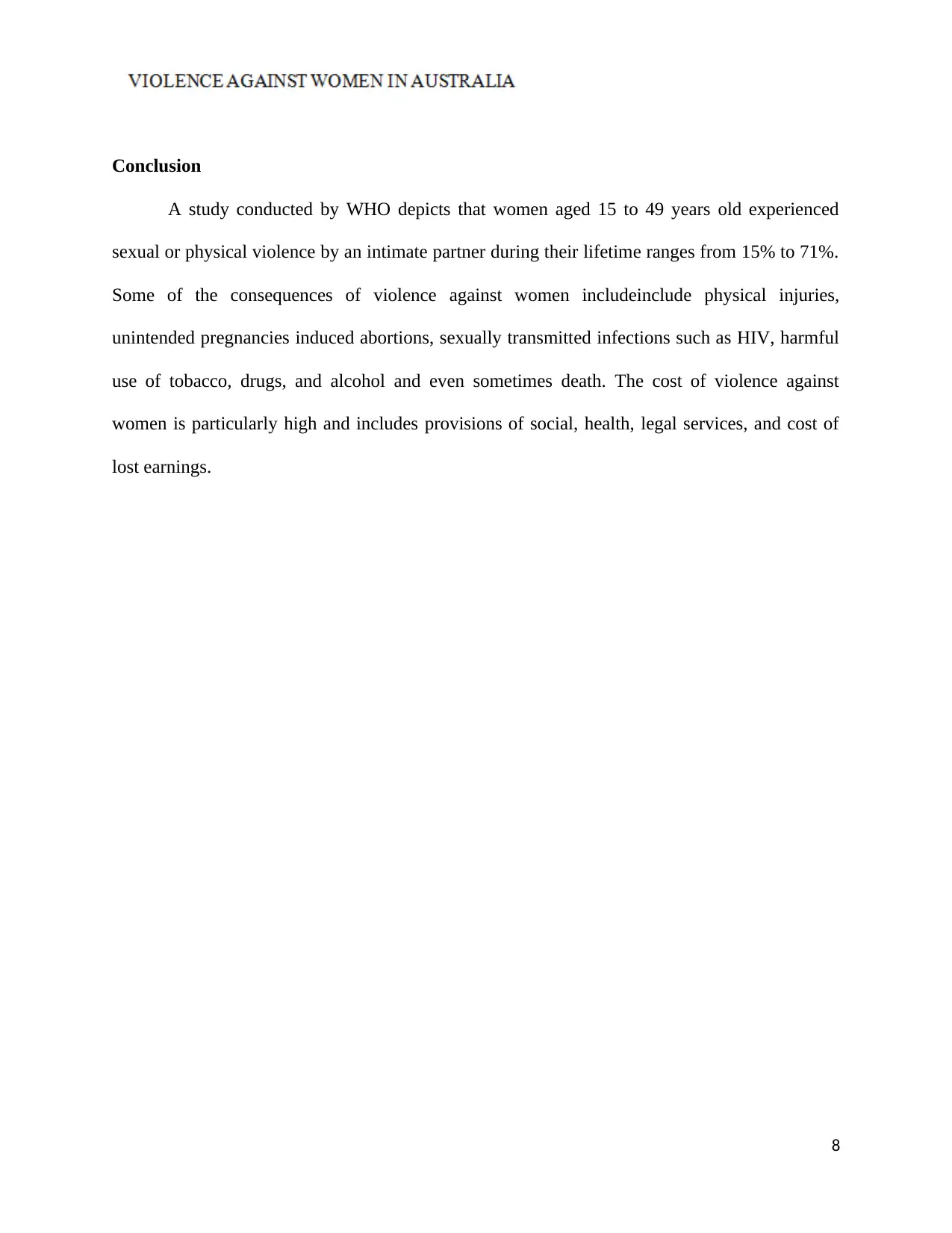
Conclusion
A study conducted by WHO depicts that women aged 15 to 49 years old experienced
sexual or physical violence by an intimate partner during their lifetime ranges from 15% to 71%.
Some of the consequences of violence against women includeinclude physical injuries,
unintended pregnancies induced abortions, sexually transmitted infections such as HIV, harmful
use of tobacco, drugs, and alcohol and even sometimes death. The cost of violence against
women is particularly high and includes provisions of social, health, legal services, and cost of
lost earnings.
8
A study conducted by WHO depicts that women aged 15 to 49 years old experienced
sexual or physical violence by an intimate partner during their lifetime ranges from 15% to 71%.
Some of the consequences of violence against women includeinclude physical injuries,
unintended pregnancies induced abortions, sexually transmitted infections such as HIV, harmful
use of tobacco, drugs, and alcohol and even sometimes death. The cost of violence against
women is particularly high and includes provisions of social, health, legal services, and cost of
lost earnings.
8
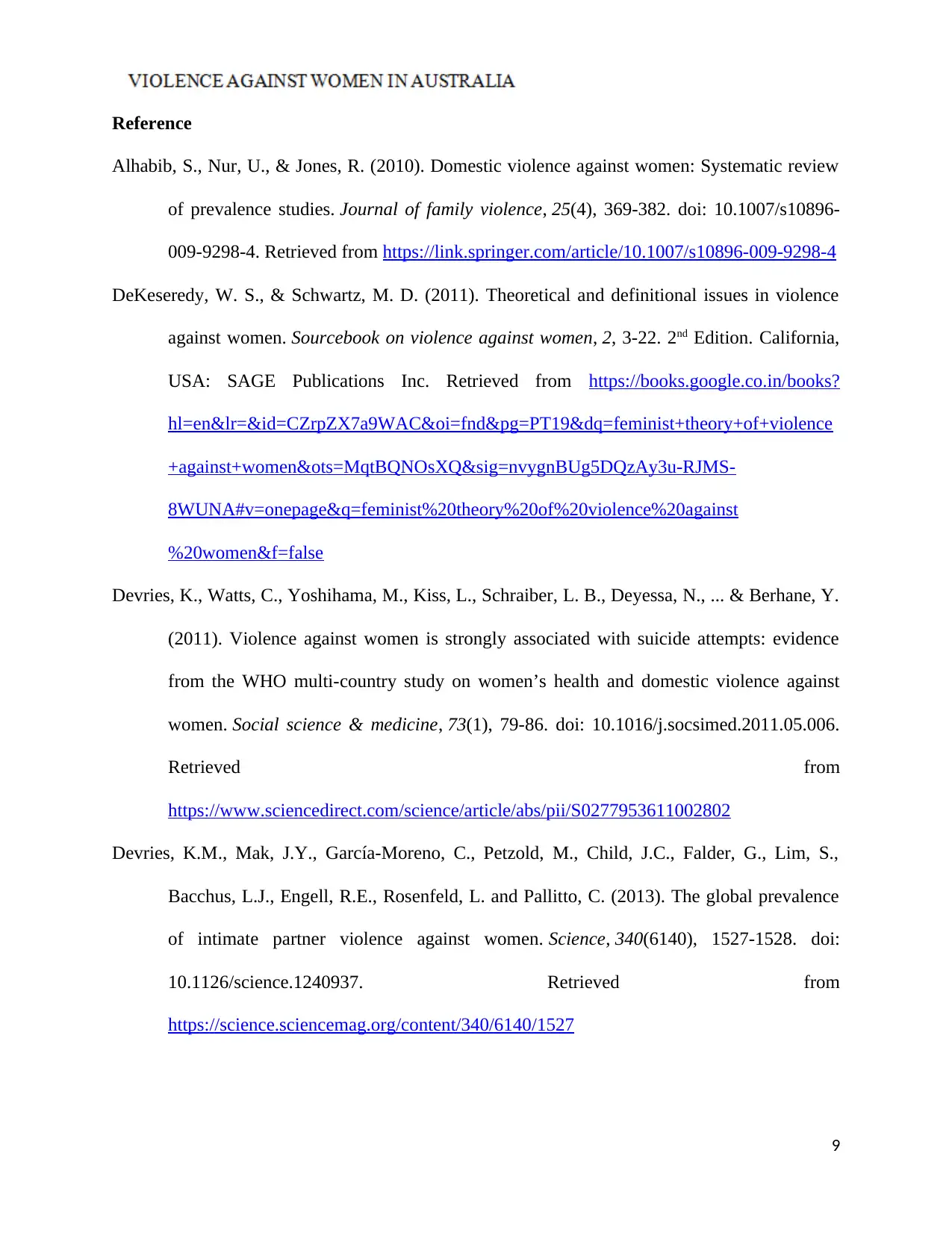
Reference
Alhabib, S., Nur, U., & Jones, R. (2010). Domestic violence against women: Systematic review
of prevalence studies. Journal of family violence, 25(4), 369-382. doi: 10.1007/s10896-
009-9298-4. Retrieved from https://link.springer.com/article/10.1007/s10896-009-9298-4
DeKeseredy, W. S., & Schwartz, M. D. (2011). Theoretical and definitional issues in violence
against women. Sourcebook on violence against women, 2, 3-22. 2nd Edition. California,
USA: SAGE Publications Inc. Retrieved from https://books.google.co.in/books?
hl=en&lr=&id=CZrpZX7a9WAC&oi=fnd&pg=PT19&dq=feminist+theory+of+violence
+against+women&ots=MqtBQNOsXQ&sig=nvygnBUg5DQzAy3u-RJMS-
8WUNA#v=onepage&q=feminist%20theory%20of%20violence%20against
%20women&f=false
Devries, K., Watts, C., Yoshihama, M., Kiss, L., Schraiber, L. B., Deyessa, N., ... & Berhane, Y.
(2011). Violence against women is strongly associated with suicide attempts: evidence
from the WHO multi-country study on women’s health and domestic violence against
women. Social science & medicine, 73(1), 79-86. doi: 10.1016/j.socsimed.2011.05.006.
Retrieved from
https://www.sciencedirect.com/science/article/abs/pii/S0277953611002802
Devries, K.M., Mak, J.Y., García-Moreno, C., Petzold, M., Child, J.C., Falder, G., Lim, S.,
Bacchus, L.J., Engell, R.E., Rosenfeld, L. and Pallitto, C. (2013). The global prevalence
of intimate partner violence against women. Science, 340(6140), 1527-1528. doi:
10.1126/science.1240937. Retrieved from
https://science.sciencemag.org/content/340/6140/1527
9
Alhabib, S., Nur, U., & Jones, R. (2010). Domestic violence against women: Systematic review
of prevalence studies. Journal of family violence, 25(4), 369-382. doi: 10.1007/s10896-
009-9298-4. Retrieved from https://link.springer.com/article/10.1007/s10896-009-9298-4
DeKeseredy, W. S., & Schwartz, M. D. (2011). Theoretical and definitional issues in violence
against women. Sourcebook on violence against women, 2, 3-22. 2nd Edition. California,
USA: SAGE Publications Inc. Retrieved from https://books.google.co.in/books?
hl=en&lr=&id=CZrpZX7a9WAC&oi=fnd&pg=PT19&dq=feminist+theory+of+violence
+against+women&ots=MqtBQNOsXQ&sig=nvygnBUg5DQzAy3u-RJMS-
8WUNA#v=onepage&q=feminist%20theory%20of%20violence%20against
%20women&f=false
Devries, K., Watts, C., Yoshihama, M., Kiss, L., Schraiber, L. B., Deyessa, N., ... & Berhane, Y.
(2011). Violence against women is strongly associated with suicide attempts: evidence
from the WHO multi-country study on women’s health and domestic violence against
women. Social science & medicine, 73(1), 79-86. doi: 10.1016/j.socsimed.2011.05.006.
Retrieved from
https://www.sciencedirect.com/science/article/abs/pii/S0277953611002802
Devries, K.M., Mak, J.Y., García-Moreno, C., Petzold, M., Child, J.C., Falder, G., Lim, S.,
Bacchus, L.J., Engell, R.E., Rosenfeld, L. and Pallitto, C. (2013). The global prevalence
of intimate partner violence against women. Science, 340(6140), 1527-1528. doi:
10.1126/science.1240937. Retrieved from
https://science.sciencemag.org/content/340/6140/1527
9
⊘ This is a preview!⊘
Do you want full access?
Subscribe today to unlock all pages.

Trusted by 1+ million students worldwide
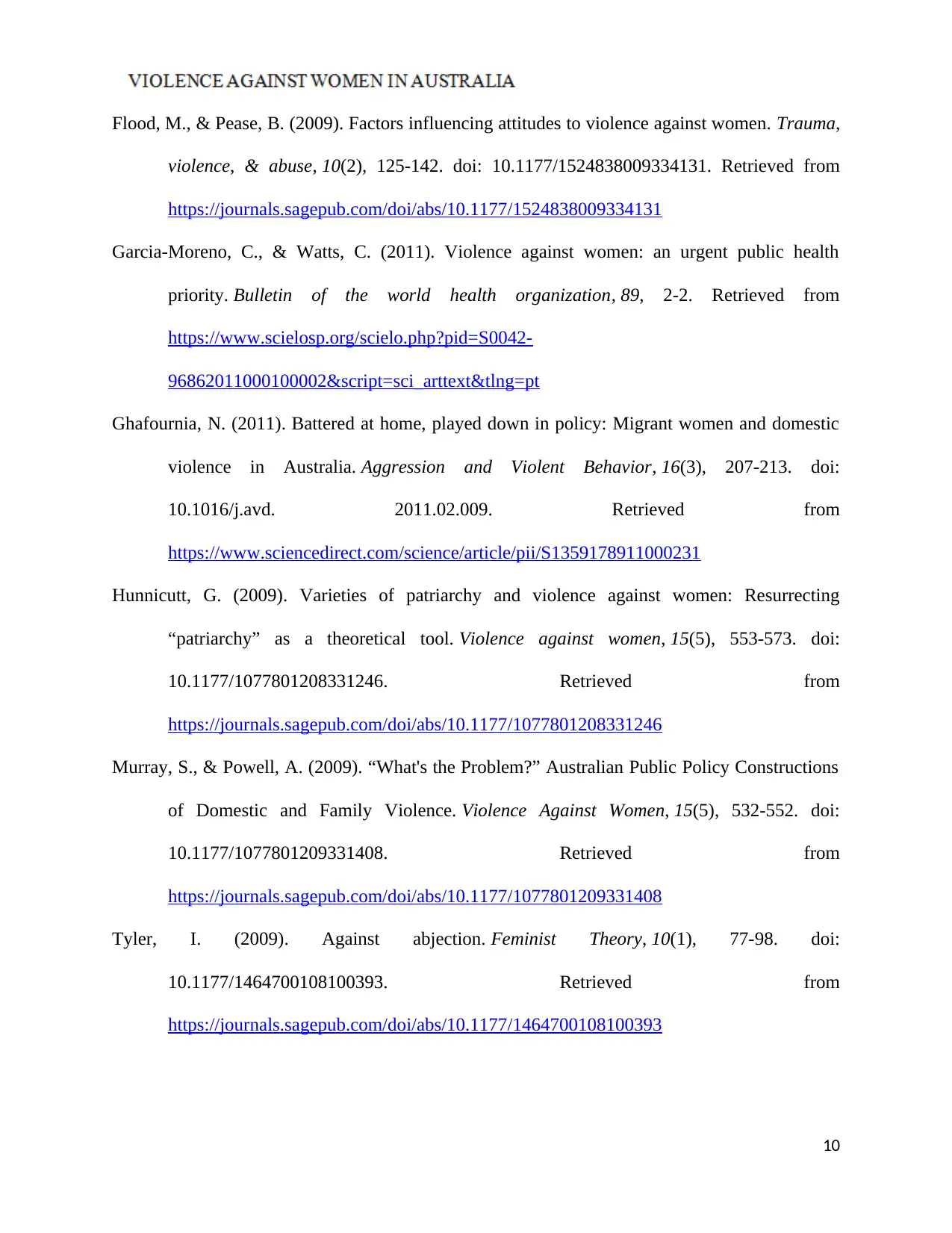
Flood, M., & Pease, B. (2009). Factors influencing attitudes to violence against women. Trauma,
violence, & abuse, 10(2), 125-142. doi: 10.1177/1524838009334131. Retrieved from
https://journals.sagepub.com/doi/abs/10.1177/1524838009334131
Garcia-Moreno, C., & Watts, C. (2011). Violence against women: an urgent public health
priority. Bulletin of the world health organization, 89, 2-2. Retrieved from
https://www.scielosp.org/scielo.php?pid=S0042-
96862011000100002&script=sci_arttext&tlng=pt
Ghafournia, N. (2011). Battered at home, played down in policy: Migrant women and domestic
violence in Australia. Aggression and Violent Behavior, 16(3), 207-213. doi:
10.1016/j.avd. 2011.02.009. Retrieved from
https://www.sciencedirect.com/science/article/pii/S1359178911000231
Hunnicutt, G. (2009). Varieties of patriarchy and violence against women: Resurrecting
“patriarchy” as a theoretical tool. Violence against women, 15(5), 553-573. doi:
10.1177/1077801208331246. Retrieved from
https://journals.sagepub.com/doi/abs/10.1177/1077801208331246
Murray, S., & Powell, A. (2009). “What's the Problem?” Australian Public Policy Constructions
of Domestic and Family Violence. Violence Against Women, 15(5), 532-552. doi:
10.1177/1077801209331408. Retrieved from
https://journals.sagepub.com/doi/abs/10.1177/1077801209331408
Tyler, I. (2009). Against abjection. Feminist Theory, 10(1), 77-98. doi:
10.1177/1464700108100393. Retrieved from
https://journals.sagepub.com/doi/abs/10.1177/1464700108100393
10
violence, & abuse, 10(2), 125-142. doi: 10.1177/1524838009334131. Retrieved from
https://journals.sagepub.com/doi/abs/10.1177/1524838009334131
Garcia-Moreno, C., & Watts, C. (2011). Violence against women: an urgent public health
priority. Bulletin of the world health organization, 89, 2-2. Retrieved from
https://www.scielosp.org/scielo.php?pid=S0042-
96862011000100002&script=sci_arttext&tlng=pt
Ghafournia, N. (2011). Battered at home, played down in policy: Migrant women and domestic
violence in Australia. Aggression and Violent Behavior, 16(3), 207-213. doi:
10.1016/j.avd. 2011.02.009. Retrieved from
https://www.sciencedirect.com/science/article/pii/S1359178911000231
Hunnicutt, G. (2009). Varieties of patriarchy and violence against women: Resurrecting
“patriarchy” as a theoretical tool. Violence against women, 15(5), 553-573. doi:
10.1177/1077801208331246. Retrieved from
https://journals.sagepub.com/doi/abs/10.1177/1077801208331246
Murray, S., & Powell, A. (2009). “What's the Problem?” Australian Public Policy Constructions
of Domestic and Family Violence. Violence Against Women, 15(5), 532-552. doi:
10.1177/1077801209331408. Retrieved from
https://journals.sagepub.com/doi/abs/10.1177/1077801209331408
Tyler, I. (2009). Against abjection. Feminist Theory, 10(1), 77-98. doi:
10.1177/1464700108100393. Retrieved from
https://journals.sagepub.com/doi/abs/10.1177/1464700108100393
10
1 out of 10
Related Documents
Your All-in-One AI-Powered Toolkit for Academic Success.
+13062052269
info@desklib.com
Available 24*7 on WhatsApp / Email
![[object Object]](/_next/static/media/star-bottom.7253800d.svg)
Unlock your academic potential
Copyright © 2020–2025 A2Z Services. All Rights Reserved. Developed and managed by ZUCOL.




